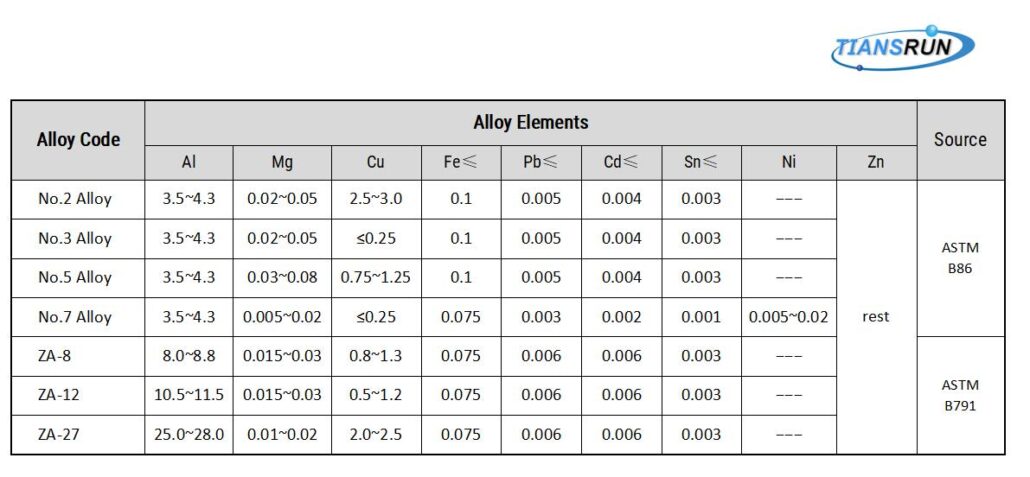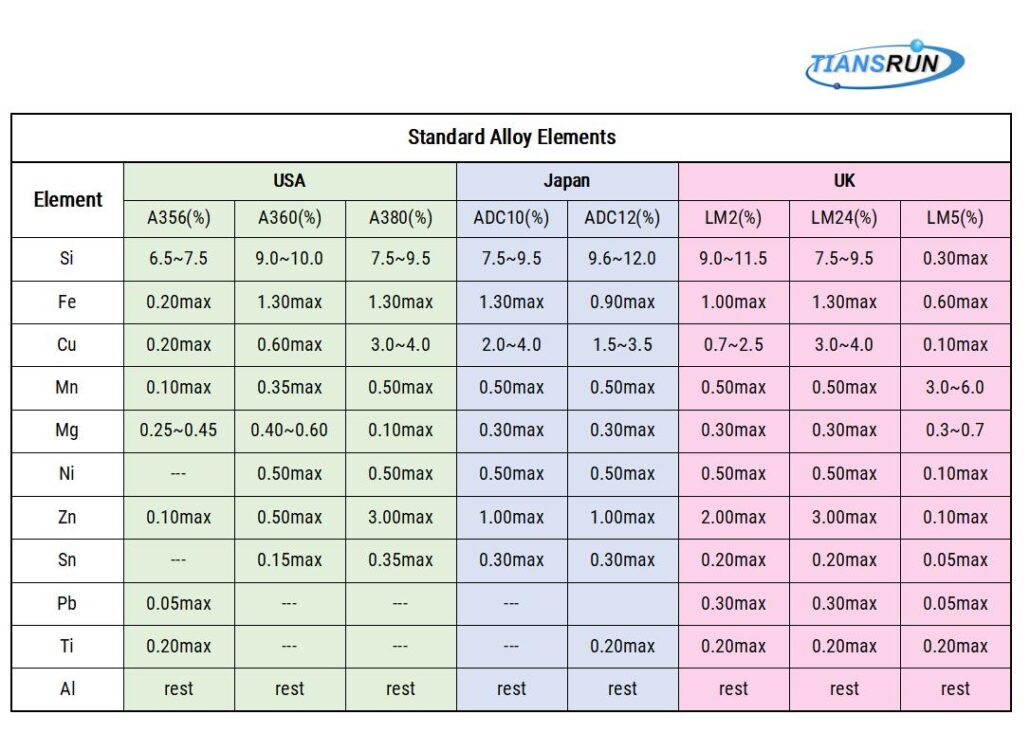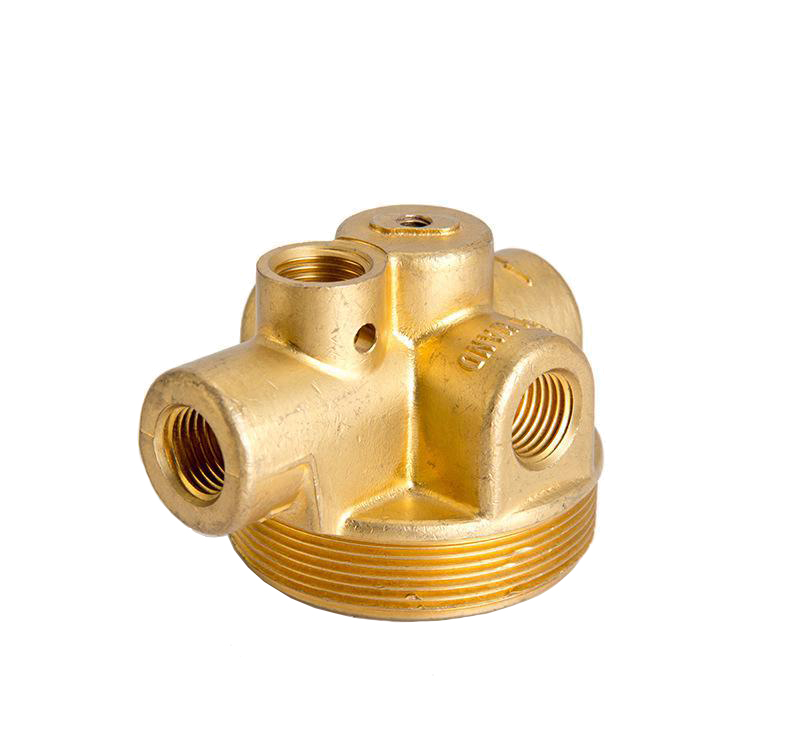Die Casting Alloy

To produce high-quality die-casting parts, in addition to a reasonable casting structure, well-manufactured molds, and a die-casting machine with superior performance, a die-casting alloy with good performance is also required.
In order to meet the use requirements of die castings and ensure the quality of die castings, die casting alloys should meet the following requirements:
- Low density, good electrical and thermal conductivity.
- High strength and hardness, good plasticity.
- Stable performance, good wear, and corrosion resistance.
- Low melting point, not easy to inhale and oxidize.
- The shrinkage rate is low, and hot crack and deformation tend to be small.
- Good fluidity, small crystallization temperature range, and small tendency to generate pores and shrinkage.
Die casting alloys are divided into low melting point alloys and higher melting point alloys. The low melting point alloys include lead, tin, and zinc alloys. On the other hand, the higher melting point alloys include aluminum, magnesium, copper, etc. Low melting point alloys are suitable for complex and precise small castings by die casting.
However, due to the low strength of lead and tin and the high price of tin, they are rarely used in machine manufacturing. The largest proportion of die castings is aluminum alloys, followed by zinc alloys and copper alloys. In recent years, the output of magnesium alloy die castings shows a rapid growth trend.

1.Zinc Alloy
Types of die-casting zinc alloys
There are two main categories of zinc alloy standard series: ZAMAK series alloys and ZA series alloys.
ZAMAK alloys include ZAMAK2, ZAMAK3, ZAMAK5, and ZAMAK7, which we often call No. 1 alloy, No. 3 alloy, No. 5 alloy, and No. 7 alloy.
ZA series includes ZA-8, ZA-12, ZA-27, and so on. ZA-8 is mainly used in hot chamber die casting machines. On the other hand, ZA-12 and ZA-27 can only be used in cold chamber die casting machines because of their special melting requirements.
Common zinc alloy chemical compositions are shown in the table below.

Properties of zinc alloys
Zinc alloy has good die-casting performance, especially high fluidity, easy filling, and can die-casting complex thin-walled castings. As a result, the requirements for mold materials are lower. However, the aging phenomenon of zinc alloys limits the application range of zinc alloys.
Selection of Zinc Alloys
Alloy 3 is the material of choice for zinc-aluminum alloy die castings. It has moderate physical and mechanical properties, good casting properties, and long-term dimensional stability. The alloy also has good surface treatment characteristics and is easy to electroplate, coat and color.

The strength and hardness of alloy No. 5 are higher than those of alloy No. 3, but its toughness is reduced, thus affecting its formability during secondary processing. In addition, its properties change because it has a 1% (mass fraction) copper addition to Alloy 3. As a result, the alloy has good castability.
Creep resistance is superior to alloy No. 3. The alloy is also easily subjected to surface treatments such as electroplating. Due to usage habits, alloy No. 5 is only selected when special strength is required.
Alloy No. 7 is an improved material by adding more Shaobin magnesium to No. 3 alloy. The purpose of adding magnesium is to improve the fluidity Q, to reduce the intergranular corrosion, a small amount of bromine is also added. The toughness of this alloy is higher than that of No. 3. This material is generally used in the manufacture of thin-walled parts.
Alloy ZA-8 has higher strength, hardness, and creep resistance than most alloys in the ZAMAK series and is only similar to Alloy 2. The surface treatment of ZA-8 alloy can use the method of ZAMAK. In use, when the No. 3 and No. 5 alloys are difficult to meet the requirements, ZA-8 alloy can be used instead.
ZA-12 can be used for both die casting and gravity casting and is a versatile alloy. It has good casting properties in sand, metal, and graphite casting.
ZA-27 alloy is a high-strength zinc alloy for gravity casting and die casting. It is light in weight and has good bearing properties and anti-wear properties. However, care should be taken to avoid internal defects in the casting when the alloy is melted. In addition, stabilization treatment is required when there are higher dimensional requirements. Under the condition that both high strength and good wear resistance are required, ZA-27 alloy is the best choice.
2.Aluminum Alloy
Types of die-casting aluminum alloys
According to the basic elements contained in the alloy, it is classified:
- Al-Si-Cu series: such as ADC10, ADC12, A380, A383
- Al-Si-Mg series: ADC3. A360.
- Al-Mg series: ADC5
Common die casting grades and corresponding standards are as follows:

The chemical composition of common aluminum alloys is as follows:

The role of alloying elements in die-casting aluminum alloys
Silicon element
It can significantly improve the fluidity of the alloy, inhibit high-temperature brittleness, and is the main alloying element in aluminum alloys. When the silicon content in the Al-Si alloy exceeds the eutectic composition and there are too many impurities of copper and iron, the hard spots of free silicon will appear. The higher the silicon content, the more free silicon, making machining difficult.
Copper element
increasing the content of copper can improve the fluidity, tensile strength, and hardness of the alloy, improve workability and reduce the tendency to stick to the mold, but reduce the elongation and corrosion resistance of the alloy, and increase the tendency of hot cracking. Usually, die casting does not use Al-Cu alloy but uses Al-Si-Cu alloy.
Magnesium element
The fluidity of Al-Mg alloy increases with the increase of magnesium content, the tendency to stick to mold decreases, but the shrinkage increases. Adding an appropriate amount of magnesium to the high-silicon aluminum alloy can improve the tensile strength, elastic limit, fatigue strength, and hardness, but the plasticity is not reduced much. Although Mg-Si has a hardening effect in Al-Si-Cu alloy, it will produce low-temperature brittleness, so the magnesium content should be limited to a certain range.
Zinc element
It can improve the fluidity of the alloy. In the aluminum alloy containing copper and silicon, adding ≤3.0% (mass fraction) of zinc helps to improve the mechanical properties. Increased zinc content in Al-Zn alloys can improve castability, mechanical properties, and machinability
Characteristics of aluminum alloys
Aluminum alloys have good die casting properties, and both electrical and thermal conductivity is good. The density of aluminum alloy is small, about 1/3 of that of zinc and copper alloys. However, the high specific strength and specific stiffness make it outstanding. Aluminum alloy casting technology is simple, forming and machinability are good. As a result, it is the best alloy to replace steel. It is also the most used alloy in the die casting industry.
A dense oxide film is easily formed on the surface of aluminum, and it has specific corrosion resistance. Therefore, most aluminum alloys have good corrosion resistance in freshwater, seawater, concentrated nitric acid, gasoline, and various organic substances. But this oxide film can be destroyed by chloride ions and alkaline ions. Therefore, aluminum is rapidly destroyed in alkalis, carbonates, hydrochloric acid, and halides.
The crystallization temperature range of aluminum alloy is small, the linear shrinkage is small, and the hot cracking tendency is also small. Still, the bulk shrinkage is large, and it is easy to form concentrated shrinkage holes. Furthermore, the affinity between aluminum alloy and iron is strong at high temperatures. Therefore, it is easy to bond with the pressure chamber, so it is customary not to use a hot die casting machine.
Application of common grades of aluminum alloys
- The most common is ADC12 (LM2), which has high castability and is suitable for most alloy castings.
- A360: It has high corrosion resistance and is often used as shell and cover parts, such as instrument shells and automobile shells.
- A380: For castings that need to maintain strength at high temperatures, such as engineering parts, brake components, carburetor parts
- A356 (LM25): For structural parts requiring high strength, such as mechanical parts and truck chassis
- A413 (ADC3): good fluidity, high castability; suitable for the production of thin parts and workpieces with complex shapes

3.Magnesium Alloy
Types of die-casting magnesium alloys
At present, the most widely used die-casting magnesium alloy is the AZ series, which has balanced mechanical properties, casting properties, and corrosion resistance and has the highest yield strength. It is generally used to manufacture thin-walled die-casting parts with complex shapes;
AM series magnesium alloys have excellent toughness and plasticity and are used on occasions with high shock loads and safety performance requirements.
AS series magnesium alloys have good creep resistance. They are commonly used in engine parts with high operating temperatures.
The chemical composition of common die-casting magnesium alloys is shown in the following figure:

Features of magnesium alloys
The biggest advantage of magnesium alloy is its low density, which is 0.65 times that of aluminum alloy. Its strength is comparable to that of aluminum alloy. Its specific strength advantage is very obvious, and its specific stiffness is comparable to that of aluminum alloy. This is very good for the forming of complex parts; it has a small affinity with iron and can be produced by a hot chamber die casting machine.
However, it has a large tendency of hot cracking. The control requirements of mold temperature and pouring temperature are strict; it is also easy to oxidize and burn, so attention should be paid to adopting protective measures in die casting operation and melting process.

4.Copper Alloy
Brass is one of the common cast copper alloys. The copper alloy has high mechanical properties; its absolute value exceeds zinc, aluminum, magnesium, and other alloys. In addition, it has good corrosion resistance in the atmosphere and seawater, a small friction coefficient, good wear resistance, fatigue limit, and thermal conductivity.
The coefficient of linear expansion is also small. Therefore, it is mostly used to manufacture parts that do not want to increase in size when they are wear-resistant, thermally conductive, or heated.
When die-casting copper alloy, the temperature is close to or higher than 1000 ℃, and the working conditions are extremely harsh. The die-casting mold has to withstand greater thermal stress and hot corrosion, the service life is short, and the requirements for mold materials are also high. Therefore, the application of copper alloy die-casting parts is less.

